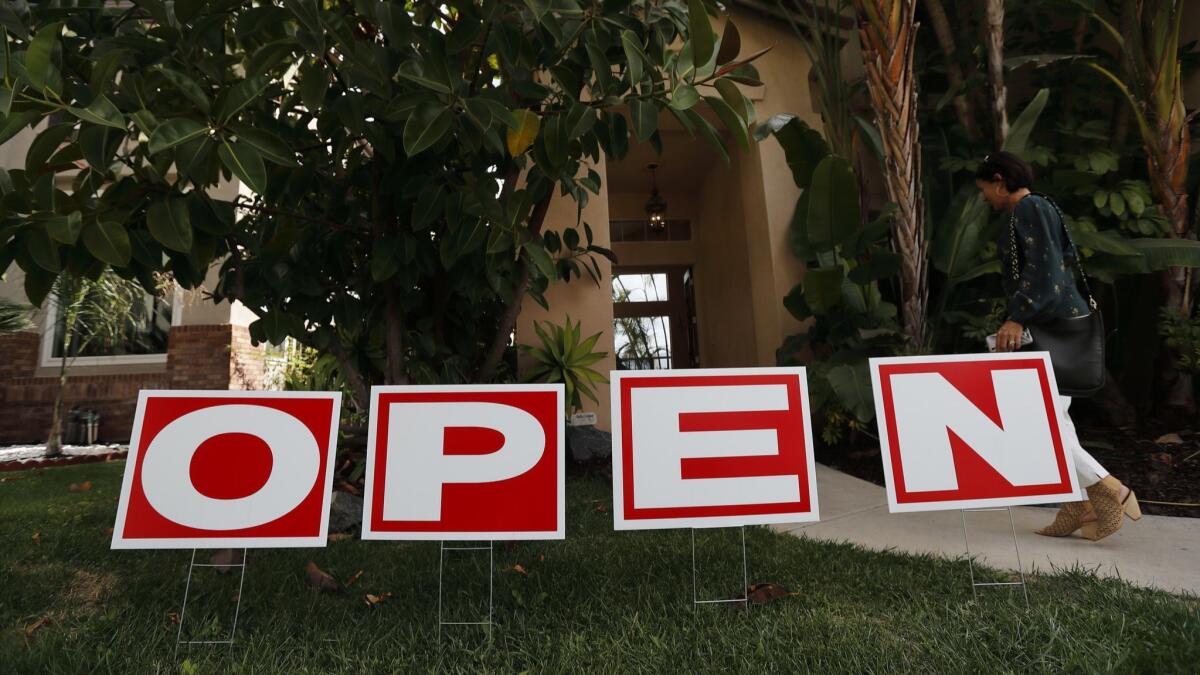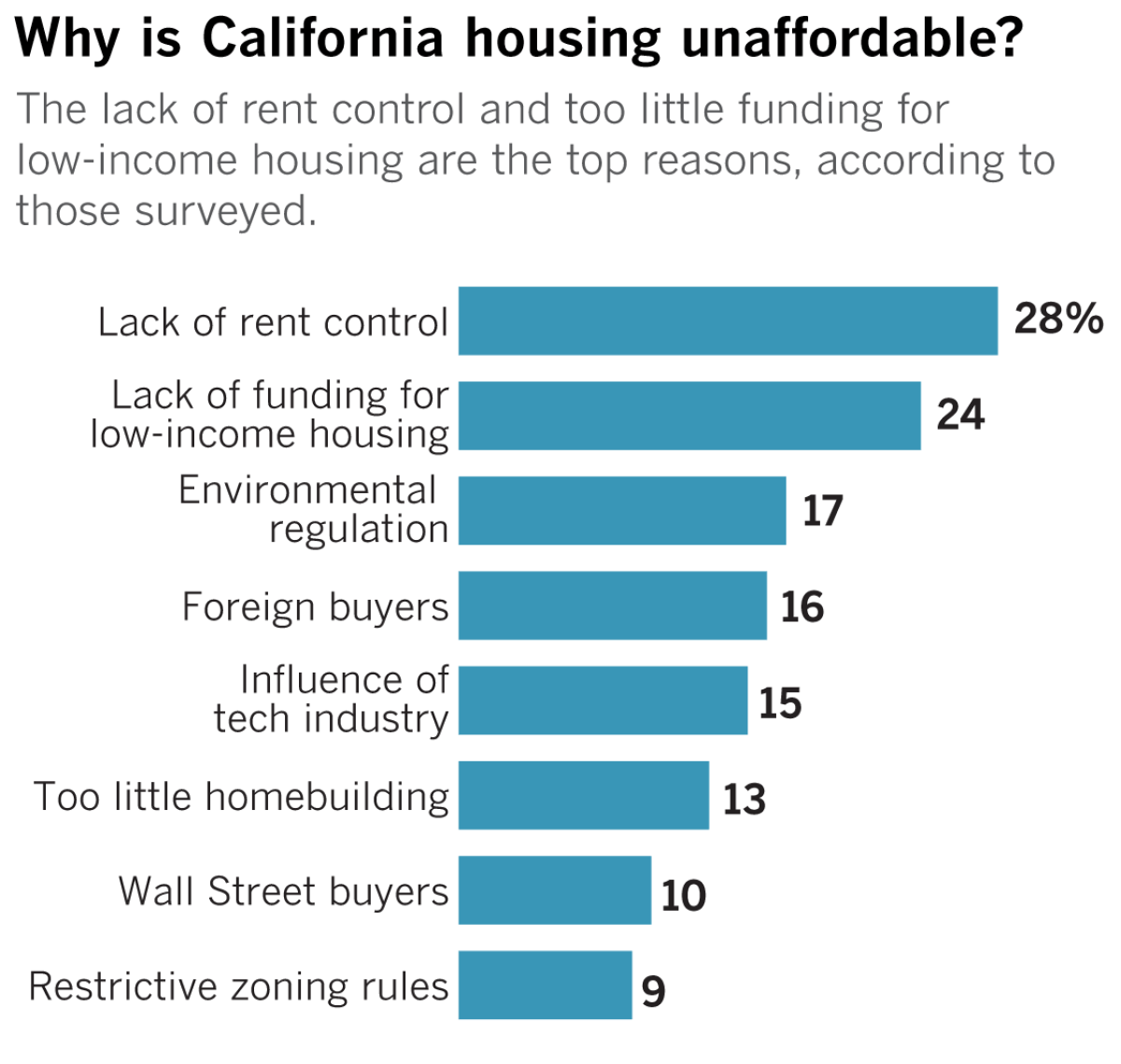Experts say California needs to build a lot more housing. But the public disagrees

Reporting from Sacramento — Academic researchers, state analysts and California’s gubernatorial candidates agree that the fundamental issue underlying the state’s housing crisis is that there are not enough homes for everyone who wants to live here.
The problem, a new poll says, is that the public doesn’t believe it.
A USC Dornsife/Los Angeles Times survey found that just 13% of eligible California voters believe that too little home building is a primary contributor to the state’s affordability issues. The answer ranked sixth among eight options offered in the poll, when first and second responses were combined. (Poll results reflect the percentage of people who chose a particular reason as their first or second option.) Lack of rent control topped the list with 28%.

Since 2011, California’s median home value has increased by almost 80% to $544,900 — nearly 2½ times the national median — according to real estate website Zillow. And 9.5 million renters in the state, more than half the tenant population, spend more than 30% of their income on rent, according to a recent analysis of U.S. census data by UC Berkeley’s Haas Institute for a Fair and Inclusive Society.
Residents are grappling with the effects of these high housing costs every day, but the poll results show that the public hasn’t rallied around a cause, said Bob Shrum, co-director of USC’s Center for the Political Future and a longtime Democratic strategist.
“There hasn’t been the kind of discussion that would actually form a consensus on what the nature of the problem is,” Shrum said.
While the public is divided, state policymakers and researchers are less so. Experts and legislators continue to debate public funding for low-income housing, the role of environmental and other state regulations and how much the tech industry’s rise and foreign and Wall Street investment play a role in the state’s overall affordability crisis.
But there’s general agreement that a lack of supply is at the root the problem. Reports from the state Department of Housing and Community Development, the nonpartisan Legislative Analyst’s Office and a host of academics contend that California has a chronic shortage of home building that has failed to keep pace with the state’s population growth — especially during the recent economic expansion — which has forced prices up.
See the results of the most recent USC Dornsife/L.A. Times polls »
The state’s gubernatorial candidates have embraced this perspective. Democratic Lt. Gov. Gavin Newsom and Republican businessman John Cox have said they would set housing production goals that call on developers in California to at least triple the current rate of building, and keep up that pace for many years to come. The result would be new housing growth at levels never seen since the building industry began keeping statistics more than six decades ago.
The Legislature already is trying to push for more housing by taking aim at some restrictions that cities and counties place on approving development. For decades, the state has set goals for housing growth for each city and county. In 2017, lawmakers passed a bill that requires local governments that have fallen behind on those goals to relax planning requirements for individual projects. Currently, just 4% of California’s 539 cities and counties are on track to meet their supply goals.
This year, a bid to boost home building by loosening local zoning rules around transit stops to allow for new apartments and condominiums attracted national attention, but failed to pass.
The poll, however, shows that residents don’t blame cities and counties for housing problems. Just 9% of those surveyed identified overly restrictive zoning rules as a primary cause of the state’s affordability problem, ranking it last out of the eight options offered. And nearly seven out of 10 of those polled believe that local governments should retain their power over individual projects, even when they’re behind on their housing goals.

Coverage of California politics »
Carolyn Coleman, executive director of the League of California Cities, said she wasn’t surprised by the results.
“This affirms what has been true for many years,” Coleman said. “Residents put most of their trust and faith in local leaders to address these issues.”
She said state officials should consider mayors and city councils as essential partners in fixing California’s housing problems instead of trying to take power away from them.
Others say poll respondents’ strong preference for keeping housing decisions local reveals why it’s been so politically difficult to address rising costs.
“Part of the reason we aren’t adding supply as fast as we need to or as densely as we need to is because of local resistance and the relationship between the local elected officials and their constituencies,” said Carol Galante, faculty director for the Terner Center for Housing Innovation at UC Berkeley. “Nobody has the motivation to make these hard choices.”
State Sen. Scott Wiener (D-San Francisco), who authored both the successful 2017 housing approval bill and this year’s failed zoning bill, said development, particularly in established neighborhoods, stirs a range of conflicting emotions that touches on people’s willingness to embrace change for them and their children.
Wiener said he sees the poll results as a sign that state officials and activists need to convince Californians of the depth of the housing shortage and how it’s contributing to rising costs.
“It’ll take time for public opinion to move, but I think we’ll get there,” Wiener said.
But even if an idea has more popular support, it wouldn’t necessarily result in policy changes.
Lack of rent control was the poll’s top finisher for why housing is unaffordable in the state. Currently, California law sets strict limits on cities and counties’ ability to expand rent control in their communities. Legislation to repeal that law quickly died in an Assembly committee at the beginning of this year. Now, Proposition 10, a November ballot initiative that also would do away with the rent control prohibitions, is trailing in the polls.
The USC/L.A. Times poll, which was conducted Sept. 17 to Oct. 14, surveyed 1,180 adult residents of California; the margin of sampling error was 3 percentage points in either direction. More information about the poll is available at bit.ly/USCpolldata.
More to Read
Get the L.A. Times Politics newsletter
Deeply reported insights into legislation, politics and policy from Sacramento, Washington and beyond. In your inbox three times per week.
You may occasionally receive promotional content from the Los Angeles Times.











